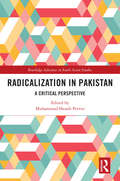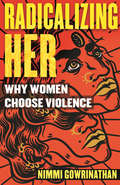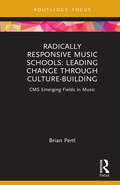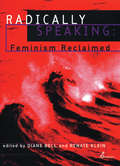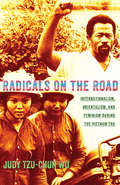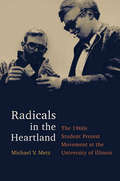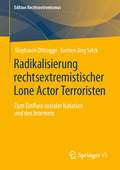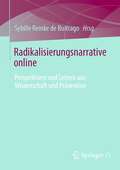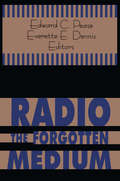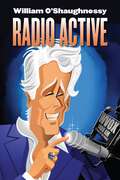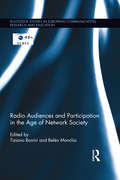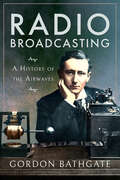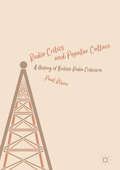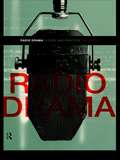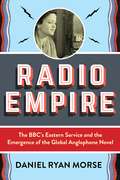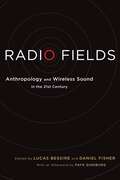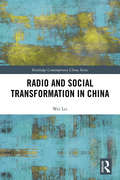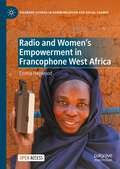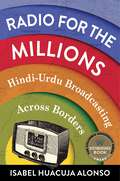- Table View
- List View
Radicalization in Pakistan: A Critical Perspective (Routledge Advances in South Asian Studies #40)
by Muhammad Shoaib PervezThis book offers a critical analysis of radicalization in Pakistan by deconstructing the global and the official state narratives designed to restrain Pakistani radicalization. Chapters are centered around three distinct themes: educational norms, religious practices and geo-political aspects of radicalization to examine the prevalent state and global practices which propagate Pakistani radicalization discourse. The book argues that there is both a global agenda which presents Pakistan as the epicentre and sponsor of terrorism and a domestic, or official, agenda that portrays Pakistan as the state which sacrificed and suffered the most in the recent War on Terror to allow the country to gain sympathy as a victim. Delineating both conflicting agendas through a critical analysis of global and state practices in order to understand the myths and narratives of Pakistan constructed by powerful elites, the book enables readers to gain a better understanding of radicalization in Pakistan. A multi-disciplinary critical approach to comprehending radicalization in Pakistan with innovative prescriptions for counter-radicalization policy, this book will be of interest to researchers working in the fields of International Relations, Security Studies, Asian Politics as well as Religious Studies and Education, in particular in the context of South Asia.
Radicalization: The Life Writings of Political Prisoners
by Melissa DeareyExpanding the influence of auto/biography studies into cultural criminology, Radicalization: The Life Writings of Political Prisoners addresses the origins, processes and cultures of terrorist criminality and political resistance in a globalized world. Criminologists and penologists have long been aware of the sheer volume of autobiography emerging from our prisons. Political prisoners, POWs, freedom fighters and terrorists have been consistently and strongly represented in this corpus of work, including such authors as Bobby Sands, Wole Soyinka, Nelson Mandela, Moazzam Begg, Ngugi wa Thiong’o, Angela Davis, George Jackson, and Aung San Suu Kyi among others. For many of those who have been detained for ostensibly politically motivated crimes, life writing has proven to be indispensable in explaining the causes and processes which account for their situation. Embedded with these life writings are narratives of radicalization or resistance. Melissa Dearey here undertakes an international and comparative analysis of such narratives, where the 'life story' is considered as a mode of expressing and transmitting 'radical' cultural values.
Radicalization: Why Some People Choose the Path of Violence
by Jane Marie Todd Farhad KhosrokhavarIn the wake of the Paris, Beirut, and San Bernardino terrorist attacks, fears over "homegrown terrorism" have surfaced to a degree not seen since September 11, 2001--especially following the news that all of the perpetrators in Paris were European citizens. A sought-after commentator in France and a widely respected international scholar of radical Islam, Farhad Khosrokhavar has spent years studying the path towards radicalization, focusing particularly on the key role of prisons--based on interviews with dozens of Islamic radicals--as incubators of a particular brand of outrage that has yielded so many attacks over the past decade.Khosrokhavar argues that the root problem of radicalization is not a particular ideology but rather a set of steps that young men and women follow, steps he distills clearly in this deeply researched account, one that spans both Europe and the United States. With insights that apply equally to far-right terrorists and Islamic radicals, Khosrokhavar argues that our security-focused solutions are pruning the branches rather than attacking the roots--which lie in the breakdown of social institutions, the expansion of prisons, and the rise of joblessness, which create disaffected communities with a sharp sense of grievance against the mainstream.
Radicalizing Her: Why Women Choose Violence
by Nimmi GowrinathanAn urgent corrective to the erasure of the female fighter from narratives on gender and power, demanding that we see all women as political actors."Violence, for me, and for the women I chronicle in this book, is simply a political reality."Though the female fighter is often seen as an anomaly, women make up nearly 30% of militant movements worldwide. Historically, these women--viewed as victims, weak-willed wives, and prey to Stockholm Syndrome--have been deeply misunderstood. Radicalizing Her holds the female fighter up in all her complexity as a kind of mirror to contemporary conversations on gender, violence, and power. The narratives at the heart of the book are centered in the Global South, and extend to a criticism of the West's response to the female fighter, revealing the arrayed forces that have driven women into battle and the personal and political elements of these decisions.Gowrinathan, whose own family history is intertwined with resistance, spent nearly twenty years in conversation with female fighters in Sri Lanka, Eritrea, Pakistan, and Colombia. The intensity of these interactions consistently unsettled her assumptions about violence, re-positioning how these women were positioned in relation to power. Gowrinathan posits that the erasure of the female fighter from narratives on gender and power is not only dangerous but also, anti-feminist.She argues for a deeper, more nuanced understanding of women who choose violence noting in particular the tendency of contemporary political discourse to parse the world into for--and against--camps: an understanding of motivations to fight is read as condoning violence, and oppressive agendas are given the upper hand by the moral imperative to condemn it. Coming at a political moment that demands an urgent re-imagining of the possibilities for women to resist, Radicalizing Her reclaims women's roles in political struggles on the battlefield and in the streets.
Radically Responsive Music Schools: Leading Change through Culture-Building (CMS Emerging Fields in Music)
by Brian PertlRadically Responsive Music Schools is a philosophical reimagining of music higher education culture from the ground up, arguing that holistic cultural change is the key factor needed for music schools to prepare 21st-century graduates for contemporary challenges.The author discusses how university and conservatory music programs can incorporate traits they seek to foster in their students – creativity, innovation, improvisation, and entrepreneurial thinking – into the institutions themselves. Through Deep Listening exercises, thought experiments, and other activities, Pertl provides detailed scaffolding for creating music school cultures of belonging and collaboration, wellbeing and intention, curiosity and wonder, creativity and improvisation, and playfulness and joy. Unpacking the complexities of transforming institutional culture, this book envisions the modern school of music as agile, collaborative, and socially aware and outlines pathways for leaders to realize this vision.Radically Responsive Music Schools is an essential resource for college-level music education administrators, professors, students, or staff members interested in how institutional culture can act as a catalyst for radical change in music programs.
Radically Speaking: Feminism Reclaimed
by Diane Bell Renate KleinShowing that a radical feminist analysis cuts across class, race, sexuality, region, and religion, the varied contributors in this collection reveal the global reach of radical feminism and analyze the causes and solutions to patriarchal oppression.
Radicals On The Road: Internationalism, Orientalism, and Feminism during the Vietnam Era (The United States in the World)
by Judy Tzu-Chun WuTraveling to Hanoi during the U. S. war in Vietnam was a long and dangerous undertaking. Even though a neutral commission operated the flights, the possibility of being shot down by bombers in the air and antiaircraft guns on the ground was very real. American travelers recalled landing in blackout conditions, without lights even for the runway, and upon their arrival seeking refuge immediately in bomb shelters. Despite these dangers, they felt compelled to journey to a land at war with their own country, believing that these efforts could change the political imaginaries of other members of the American citizenry and even alter U. S. policies in Southeast Asia. In Radicals on the Road, Judy Tzu-Chun Wu tells the story of international journeys made by significant yet underrecognized historical figures such as African American leaders Robert Browne, Eldridge Cleaver, and Elaine Brown; Asian American radicals Alex Hing and Pat Sumi; Chicana activist Betita Martinez; as well as women's peace and liberation advocates Cora Weiss and Charlotte Bunch. These men and women of varying ages, races, sexual identities, class backgrounds, and religious faiths held diverse political views. Nevertheless, they all believed that the U. S. war in Vietnam was immoral and unjustified. In times of military conflict, heightened nationalism is the norm. Powerful institutions, like the government and the media, work together to promote a culture of hyperpatriotism. Some Americans, though, questioned their expected obligations and instead imagined themselves as "internationalists," as members of communities that transcended national boundaries. Their Asian political collaborators, who included Buddhist monk Thich Nhat Hanh, Foreign Minister of the Provisional Revolutionary Government Nguyen Thi Binh and the Vietnam Women's Union, cultivated relationships with U. S. travelers. These partners from the East and the West worked together to foster what Wu describes as a politically radical orientalist sensibility. By focusing on the travels of individuals who saw themselves as part of an international community of antiwar activists, Wu analyzes how actual interactions among people from several nations inspired transnational identities and multiracial coalitions and challenged the political commitments and personal relationships of individual activists.
Radicals in the Heartland: The 1960s Student Protest Movement at the University of Illinois
by Michael V. MetzIn 1969, the campus tumult that defined the Sixties reached a flash point at the University of Illinois. Out-of-town radicals preached armed revolution. Students took to the streets and fought police and National Guardsmen. Firebombs were planted in lecture halls while explosions rocked a federal building on one side of town and a recruiting office on the other. Across the state, the powers-that-be expressed shock that such events could take place at Illinois's esteemed, conservative, flagship university--how could it happen here, of all places? Positioning the events in the context of their time, Michael V. Metz delves into the lives and actions of activists at the center of the drama. A participant himself, Metz draws on interviews, archives, and newspaper records to show a movement born in demands for free speech, inspired by a movement for civil rights, and driven to the edge by a seemingly never-ending war. If the sudden burst of irrational violence baffled parents, administrators, and legislators, it seemed inevitable to students after years of official intransigence and disregard. Metz portrays campus protesters not as angry, militant extremists but as youthful citizens deeply engaged with grave moral issues, embodying the idealism, naiveté, and courage of a minority of a generation.
Radikale Werte: Die Interessen der Menschen und ihre gesellschaftlich-politische Durchsetzung
by Max HallerEin berühmter, immer wieder zitierter Satz von Max lautet: „Interessen (materielle und ideelle), nicht: Ideen, beherrschen unmittelbar das Handeln der Menschen. Aber: die ‚Weltbilder‘, welche durch ‚Ideen‘ geschaffen wurden, haben sehr oft als Weichensteller die Bahnen bestimmt, in denen die Dynamik der Interessen das Handeln fortbewegte.“ Die neuere Soziologie ist diesem Grundsatz allerdings nicht gerecht geworden. Werte und ihre Wirkung werden entweder als gegeben vorausgesetzt (so bei Talcott Parsons) oder überhaupt als irrelevant betrachtet (so in der Rational Choice- und Systemtheorie). Die umfangreiche, empirische Werteforschung hat vielfältige Ergebnisse erbracht, blieb jedoch weitgehend ohne theoretisches Fundament, sodass ihre Befunde vielfach anfechtbar sind. Weber selbst gab im Hinblick auf die Frage nach der Relevanz der Werte nur unbefriedigende Antworten: Die Entscheidung für bestimmte Werte sei eine rein individuelle Angelegenheit und zwischen den verschiedenenWerten gebe es einen unversöhnlichen Kampf. Im vorliegenden Buch wird diese Problematik erstmals in der deutschen Soziologie umfassend untersucht und es wird dafür (u.a. im Anschluss an Autoren wie Immanuel Kant, George H. Mead und Raymond Boudon), eine neue, konstruktive und erklärungsstarke Lösung gefunden. Unter Zuhilfenahme von Überlegungen aus Philosophie, Sozialtheorie und empirischer Sozialforschung sowie unter Einbeziehung historischer Kämpfe zur Anerkennung und Durchsetzung der Werte kann man feststellen, dass es gesellschaftliche Grundwerte gibt, dass deren Anzahl klar bestimmbar ist und dass zwischen ihnen keineswegs Konflikt, sondern Komplementarität besteht. Mit diesen Thesen und Befunden kann dieses Buch als neues soziologisches Standardwerk angesehen werden. Es hat auch für Vertreter vieler anderer geistes- und sozialwissenschaftlicher Disziplinen grundlegende Bedeutung.
Radikalisierung rechtsextremistischer Lone Actor Terroristen: Zum Einfluss sozialer Isolation und des Internets (Edition Rechtsextremismus)
by Stephanie Ohlrogge Torsten Jörg SelckÜber den Einfluss sozialer Isolation und des Internets auf die Radikalisierung von rechtsextremistischen Lone Actor Terroristen liegen bislang kaum theoretische und empirische Erkenntnisse vor, sodass die Untersuchung an dieser Forschungslücke anknüpft. Auf Basis einer vergleichenden Fallstudie werden praxisnah neue theoretische Erkenntnisse über die Wirkmechanismen der beiden Radikalisierungsfaktoren gewonnen. Insbesondere Online-Plattformen mit radikalen Communities spielen eine zentrale Rolle und können sowohl bei sozial isolierten als auch bei integrierten Einzeltätern gruppenbasierte Radikalisierungsprozesse initiieren.
Radikalisierungsnarrative online: Perspektiven und Lehren aus Wissenschaft und Prävention
by Sybille Reinke de BuitragoRadikalisierung hin zu extremistischen Milieus findet seit etlichen Jahren auch gezielt online statt. Während der Kontakt zu extremistischen Akteuren weiterhin auch offline geschieht, spielen die sozialen Medien in Radikalisierungsverläufen zunehmend eine wichtige Rolle. So werden Jugendliche in YouTube-Videos und auf anderen Plattformen der sozialen Medien aktiv von extremistischen Akteuren angesprochen und zu extremistischen Inhalten hingeleitet. Die Untersuchung und Offenlegung von Radikalisierungsnarrativen online ist daher eine wichtige Aufgabe für Wissenschaft und Prävention. In den Bemühungen um De-Radikalisierung bzw. Hemmung oder Prävention von Radikalisierung können auch Gegennarrative bzw. alternative Narrative eine Rolle spielen. Gegennarrative versuchen, Radikalisierungsnarrative zu dekonstruieren, falsche Zusammenhänge und Widersprüche offenzulegen und alternative bzw. rechtsstaatliche, demokratische Deutungen von bestehenden Problemen aufzuzeigen. Diese Gegennarrative können sowohl online verfügbar gemacht sowie in der Jugendarbeit für die Prävention genutzt werden.Der Sammelband greift diese Thematik auf, indem er wichtige Erkenntnisse aus Wissenschaft und Prävention zusammenbringt.
Radio - The Forgotten Medium
by Everette E. Dennis Edward C. PeaseAlthough television is now dominant, radio surprisingly remains a medium of unparalleled power and importance. Worldwide, it continues to be the communications vehicle with the greatest outreach and impact. Every indicator - economic, demographic, social, and democratic - suggests that far from fading away, radio is returning to our consciousness, and back into the cultural mainstream.Marilyn J. Matelski reviews radio's glory days, arguing that the glory is not all in the past. B. Eric Rhoads continues Matelski's thoughts by explaining how and why radio has kept its vitality. The political history of radio is reviewed by Michael X. Delli Carpini, while David Bartlett shows how one of radio's prime functions has been to serve the public in time of disaster. Other contributors discuss radio as a cultural expression; the global airwaves; and the economic, regulatory, social, and technological structures of radio.Collectively, the contributors provide an intriguing study into the rich history of radio, and its impact on many areas of society. It provides a wealth of information for historians, sociologists, and communications and media scholars. Above all, it helps explain how media intersect, change focus, but still manage to survive and grow in a commercial environment.
Radio Active
by William O'ShaughnessyRadio Active is William O’Shaughnessy’s fifth collection of essays, on-air interviews, tributes and eulogies, endorsements, recollections of an evening, and more from “perhaps the finest broadcaster in America” whose commentaries are akin to “potato chips” per former Secretary of State Henry Kissinger because “You can’t stop with only one.”The book opens with a ringing signature defense of the First Amendment and collected O’Shaughnessy correspondence with heroes and “villains,” and insightful sections honoring former New York Governor Mario Cuomo, who said, “When O’Shaughnessy is on his game . . . he’s better than anyone on the air or in print.” There is also a section on the estimable Bush family.In eliciting “provocative and candid revelations” from his wide circle, this new compendium pulses with brilliant, insightful prose and a life-affirming reverence for luminous people, places, and events, past and present.
Radio Activism: Breaking the Silence and Empowering Women (Concepts for Critical Psychology)
by Annette RimmerThis unique book draws on the narratives of women participants in community radio, using intersectionality, feminist, critical psychological and community development frameworks to explore how this highly symbolic, creative dimension of activism can unmute marginalised women and enrich corporate media. Over a period of four years, twelve female radio project volunteers offer their experiences which they analyse, together as part of the RRG (Radio Research Group), alongside a conceptual and contextual framework to produce insights on the gendered nature of silence, voice and empowerment, and the wider potential of radio activism. Employing literature from a variety of fields, from bell hooks to Stuart Hall, the book foregrounds evidence from the majority world to argue the empowerment potential of community radio and the barriers to radio participation. Through this analysis community radio emerges as a site of development, from which diverse identities transpire through laughter, dialogue, raised consciousness and solidarity, but it also exposes the conflicts of empowerment by recognising inherent tensions in womanhood and in communities. Centering on the global, hegemonic challenge of empowering women, and relevant across multiple disciplines and professions, this is fascinating reading for academics, students and professionals in psychology, gender studies, media studies, development and related areas.
Radio Audiences and Participation in the Age of Network Society (Routledge Studies in European Communication Research and Education)
by Tiziano Bonini BelThis book maps, describes and further explores all contemporary forms of interaction between radio and its public, with a specific focus on those forms of content co-creation that link producers and listeners. Each essay will analyze one or more case studies, piecing together a map of emerging co-creation practices in contemporary radio. Contributors describe the rise of a new class of radio listeners: the networked ones. Networked audiences are made up of listeners that are not only able to produce written and audio content for radio and co-create along with the radio producers (even definitively bypassing the central hub of the radio station, by making podcasts), but that also produce social data, calling for an alternative rating system, which is less focused on attention and more on other sources, such as engagement, sentiment, affection, reputation, and influence. What are the economic and political consequences of this paradigm shift? How are radio audiences perceived by radio producers in this new radioscape? What’s the true value of radio audiences in this new frame? How do radio audiences take part in the radio flow in this age? Are audiences’ interactions and co-creations overrated or underrated by radio producers? To what extent listeners' generated content can be considered a form of participation or "free labour" exploitation? What’s the role of community radio in this new context? These are some of the many issues that this book aims to explore. Visit https://www.facebook.com/pages/Radio-Audience-and-Participation-in-the-Age-of-Network-Society/869169869799842 for the book's Facebook page.
Radio Broadcasting: A History of the Airwaves
by Gordon BathgateAn in-depth look at a century of radio history—and its continuing relevance in a radically changed world.A century after Marconi’s experimental transmissions, this book examines the history of radio and traces its development from theories advanced by James Clerk Maxwell and Heinrich Hertz to the first practical demonstrations by Guglielmo Marconi. It looks back to the pioneering broadcasts of the BBC, examines the development of broadcast networks in North America and around the world, and spotlights radio’s role in the Second World War.The book also features the radio programs and radio personalities that made a considerable impact on listeners during the “Golden Era.” It examines how radio, faced by competition from television, adapted and survived. Indeed, radio has continued to thrive despite increased competition from mobile phones, computers, and other technological developments. Radio Broadcasting looks ahead and speculates on how radio will fare in a multi-platform future.
Radio Critics and Popular Culture: A History Of British Radio Criticism
by Paul RixonRadio still remains an important form of media, with millions listening to it daily. It has been reborn for the digital era, and is an area where there is great interest in its development, role and form. Attempting to fill the gap in research on British radio criticism, this volume explores the development and role of radio criticism in the discourse around radio in Britain from its birth in the 1920s up to present day. Using a historical approach to explore how, as radio emerged, the press provided coverage which helped shape and reflect radio’s position in popular culture, Paul Rixon delivers an interesting and engaging exploration that provides a cultural perspective on radio, with a specific focus on newspaper criticism. Radio Critics and Popular Culture is an innovative and original addition to existing research and will be invaluable for those interested in the way that British radio has evolved.
Radio Drama: Theory And Practice
by Tim CrookRadio Drama brings together the practical skills needed for radio drams, such as directing, writing and sound design, with media history and communication theory.Challenging the belief that sound drama is a 'blind medium', Radio Drama shows how experimentation in radio narrative has blurred the dividing line between fiction and reality in modern media. Using extracts from scripts and analysing radio broadcasts from America, Britain, Canada and Australia, the book explores the practicalities of producing drama for radio. Tim Crook illustrates how far radio drama has developed since the first 'audiophonic production' and evaluates the future of radio drama in the age of live phone-ins and immedate access to programmes on the Internet.
Radio Empire: The BBC’s Eastern Service and the Emergence of the Global Anglophone Novel (Modernist Latitudes)
by Daniel Ryan MorseInitially created to counteract broadcasts from Nazi Germany, the BBC’s Eastern Service became a cauldron of global modernism and an unlikely nexus of artistic exchange. Directed at an educated Indian audience, its programming provided remarkable moments: Listeners in India heard James Joyce reading from Finnegans Wake on the eve of independence, as well as the literary criticism of E. M. Forster and the works of Indian writers living in London.In Radio Empire, Daniel Ryan Morse demonstrates the significance of the Eastern Service for global Anglophone literature and literary broadcasting. He traces how modernist writers used radio to experiment with form and introduce postcolonial literature to global audiences. While innovative authors consciously sought to incorporate radio’s formal features into the novel, literature also exerted a reciprocal and profound influence on twentieth-century broadcasting. Reading Joyce and Forster alongside Attia Hosain, Mulk Raj Anand, and Venu Chitale, Morse demonstrates how the need to appeal to listeners at the edges of the empire pushed the boundaries of literary work in London, inspired high-cultural broadcasting in England, and formed an invisible but influential global network.Adding a transnational perspective to scholarship on radio modernism, Radio Empire demonstrates how the history of broadcasting outside of Western Europe offers a new understanding of the relationship between colonial center and periphery.
Radio Fields: Anthropology and Wireless Sound in the 21st Century
by Daniel Fisher Lucas BessireRadio is the most widespread electronic medium in the world today. As a form of technology that is both durable and relatively cheap, radio remains central to the everyday lives of billions of people around the globe. It is used as a call for prayer in Argentina and Appalachia, to organize political protest in Mexico and Libya, and for wartime communication in Iraq and Afghanistan. In urban centers it is played constantly in shopping malls, waiting rooms, and classrooms. Yet despite its omnipresence, it remains the media form least studied by anthropologists.Radio Fields employs ethnographic methods to reveal the diverse domains in which radio is imagined, deployed, and understood. Drawing on research from six continents, the volume demonstrates how the particular capacities and practices of radio provide singular insight into diverse social worlds, ranging from aboriginal Australia to urban Zambia. Together, the contributors address how radio creates distinct possibilities for rethinking such fundamental concepts as culture, communication, community, and collective agency.
Radio and Social Transformation in China (Routledge Contemporary China Series)
by Wei LeiThe first systematic, comprehensive and critical English-language study of radio in China, this book documents a historical understanding of Chinese radio from the early twentieth century to the present. Covering both public matters and private lives, Radio and Social Transformation in China analyses a range of themes from healthcare, migration and education, to intimacy, family and friendship. Through a concentrated and thorough scrutiny of a variety of new genres and radio practices in post-Mao China, it also investigates the interaction between radio and social change, particularly in the era of economic reform. Building on the core theoretical concept of ‘compressed modernity’, each of the radio genres explored is shown to embody China’s efforts to achieve modernity, while simultaneously exemplifying radio’s capacity to manage the challenges that have arisen from the country’s distinctive and perhaps unique process of modernization. Written in an engaging style, this book makes an important contribution to radio history internationally. As such, it will be of great interest to students and scholars of broadcast media, radio and Communication Studies, as well as Chinese culture and society.
Radio and Women's Empowerment in Francophone West Africa (Palgrave Studies in Communication for Social Change)
by Emma HeywoodThis open access book breaks new ground by examining the significant role played by radio in empowering women in three Francophone West African countries: Mali, Niger and Burkina Faso.It examines the representation and perception of key themes broadcast by radio and associated with women’s empowerment in the three countries. Each chapter contextualises a specific topic in the country and then explores discrete aspects of radio’s provision. The topics covered in the chapters are women’s political engagement; women and finances; women and life within marriage; inheritance; women’s involvement in radio structures; and radio, internally displaced women, and trauma.Given the social, economic and political vulnerability and deteriorating security situation of the three countries, this book provides a timely and meaningful contribution to acknowledging and understanding the vital role of radio in women’s empowerment.
Radio and the Gendered Soundscape
by Christine EhrickThis book is a history of women, radio, and the gendered constructions of voice and sound in Buenos Aires, Argentina, and Montevideo, Uruguay. Through the stories of five women and one radio station, this study makes a substantial theoretical contribution to the study of gender, mass media, and political culture and expands our knowledge of these issues beyond the US and Western Europe. Included here is a study of the first all-women's radio station in the Western Hemisphere, an Argentine comedian known as 'Chaplin in Skirts', an author of titillating dramatic serials and, of course, Argentine First Lady 'Evita' Perón. Through the concept of the gendered soundscape, this study integrates sound studies and gender history in new ways, asking readers to consider both the female voice in history and the sonic dimensions of gender.
Radio and the Politics of Sound in Interwar France, 1921–1939
by Rebecca P. ScalesIn December 1921, France broadcast its first public radio program from a transmitter on the Eiffel Tower. In the decade that followed, radio evolved into a mass media capable of reaching millions. Crowds flocked to loudspeakers on city streets to listen to propaganda, children clustered around classroom radios, and families tuned in from their living rooms. Radio and the Politics of Sound in Interwar France, 1921–1939 examines the impact of this auditory culture on French society and politics, revealing how broadcasting became a new platform for political engagement, transforming the act of listening into an important, if highly contested, practice of citizenship. Rejecting models of broadcasting as the weapon of totalitarian regimes or a tool for forging democracy from above, the book offers a more nuanced picture of the politics of radio by uncovering competing interpretations of listening and diverse uses of broadcast sound that flourished between the world wars.
Radio for the Millions: Hindi-Urdu Broadcasting Across Borders
by Isabel Huacuja AlonsoFrom news about World War II to the broadcasting of music from popular movies, radio played a crucial role in an increasingly divided South Asia for more than half a century. Radio for the Millions examines the history of Hindi-Urdu radio during the height of its popularity from the 1930s to the 1980s, showing how it created transnational communities of listeners.Isabel Huacuja Alonso argues that despite British, Indian, and Pakistani politicians’ efforts to usurp the medium for state purposes, radio largely escaped their grasp. She demonstrates that the medium enabled listeners and broadcasters to resist the cultural, linguistic, and political agendas of the British colonial administration and the subsequent independent Indian and Pakistani governments. Rather than being merely a tool of nation building in South Asia, radio created affective links that defied state agendas, policies, and borders. It forged an enduring transnational soundscape, even after the 1947 Partition had made a united India a political impossibility.Huacuja Alonso traces how people engaged with radio across news, music, and drama broadcasts, arguing for a more expansive definition of what it means to listen. She develops the concept of “radio resonance” to understand how radio relied on circuits of oral communication such as rumor and gossip and to account for the affective bonds this “talk” created. By analyzing Hindi film-song radio programs, she demonstrates how radio spurred new ways of listening to cinema. Drawing on a rich collection of sources, including newly recovered recordings, listeners’ letters to radio stations, original interviews with broadcasters, and archival documents from across three continents, Radio for the Millions rethinks assumptions about how the medium connects with audiences.
